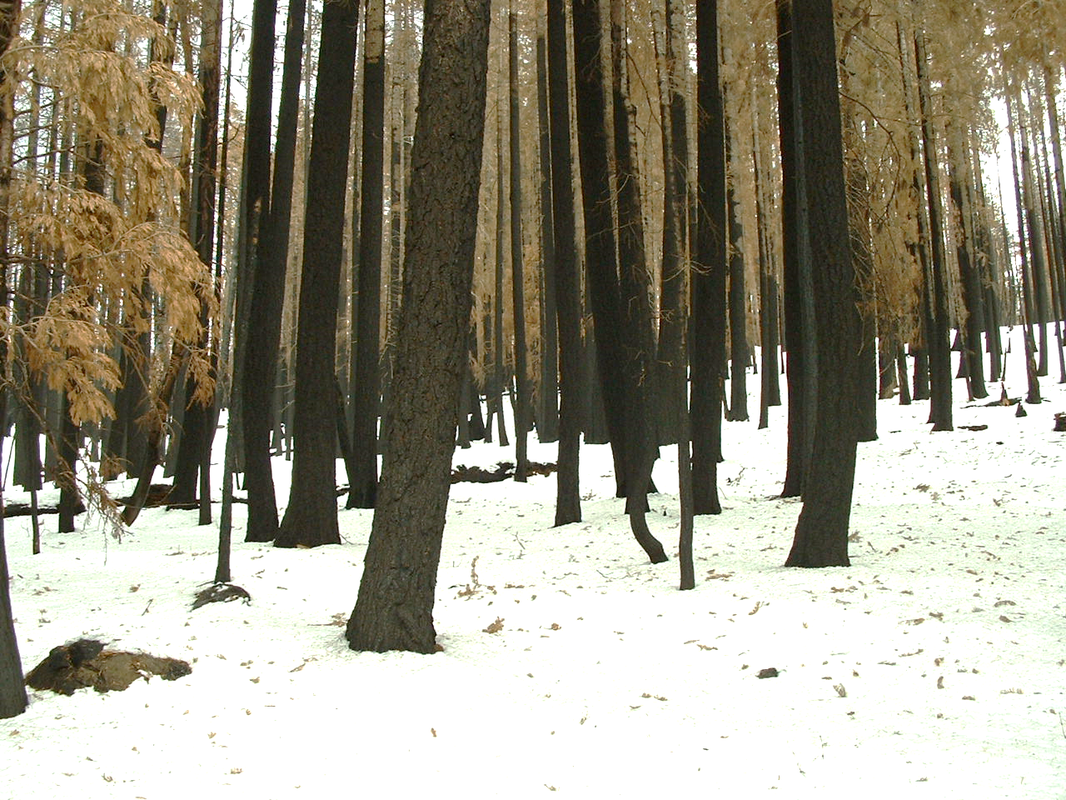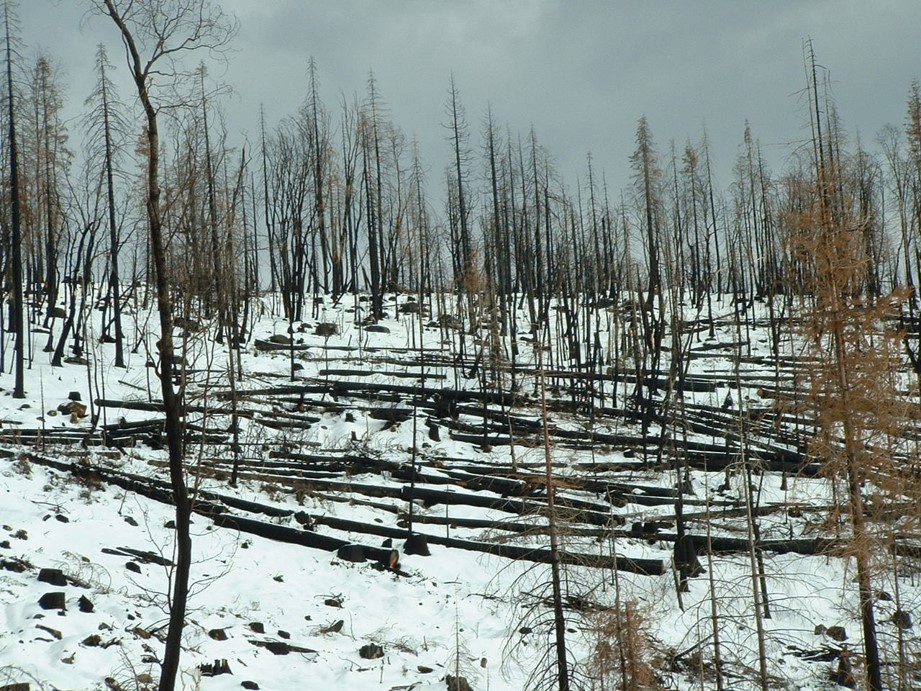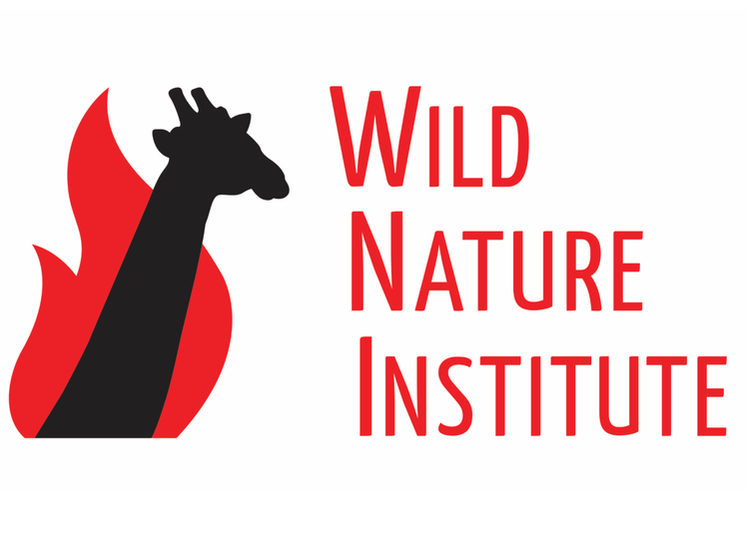It's Getting Hot in Here: A New Paradigm About Spotted Owls and Fire
The Spotted Owl (Strix occidentalis) is one of the most iconic old-growth-dependent bird species in the Pacific Northwest, California, and Southwest. This imperiled bird of prey typically nests, roosts, and forages in dense conifer and mixed conifer-oak forests dominated by large, old trees and peppered with big, decadent snags and fallen logs. High levels of canopy cover from overhead foliage is another important component of nesting and roosting stands; thus, it has long been presumed that Spotted Owls were seriously harmed where severe fire burned the forest canopy.
Yet, the forests where these owls dwell have experienced mixed- and high-severity fire for millennia—so how do these birds actually respond when severe fire affects habitat within their home ranges?
Several studies have now demonstrated that Spotted Owls can survive and thrive (successfully reproduce) within territories that have experienced moderate- and high-severity fire. Research published by Wild Nature Institute’s scientists and others have found the following:
- Spotted owls generally survive and continue to reproduce in territories that experienced severe fire.
- Only marginal sites (often vacant and non-reproductive) have lower occupancy after severe fire.
- Spotted owls nest and roost in stands with high canopy cover (unburned/low burned) even in burned landscapes.
- Spotted owls forage in severely burned stands.
- Home-range sizes are similar in burned and unburned landscapes.
- Post-fire logging causes territory abandonment and reduces survival.
In these studies, Spotted Owls still preferred to nest and roost in green forests, underscoring the importance of unburned or low-severity refugia within the larger landscape mosaic of mixed-severity fire. But where severe fire is natural, even old-growth species partake of its bounty. The Spotted Owl paradigm is telling us that natural fire regimes provide a bedroom, nursery, and kitchen, as long as the burned forest is left standing.
Scientific publications by Wild Nature Institute scientists about Spotted Owls and Forest Fire:
· Bond et al. 2022. Forest management, Barred Owls, and Wildfire in Northern Spotted Owl Territories.
· Hanson et al. 2021. Disentangling post-fire logging and high-severity fire effects for spotted owls.
· Lee 2020. Spotted Owls and forest fire: Reply.
· Lee et al. 2019. We refute the "conundrum of agenda-driven science," a comment on Peery et al. 2019. and Supporting Information.
· Lee 2018. Spotted Owls and forest fire: a systematic review and meta-analysis of the evidence.
· Hanson et al. 2018. Effects of post-fire logging on California spotted owl occupancy.
· Bond et al. 2016. Foraging habitat selection by California spotted owls after fire.
· Lee and Bond 2015. Previous year’s reproductive state affects Spotted Owl site occupancy and reproduction responses to natural and anthropogenic disturbances.
· Lee and Bond 2015. Occupancy of California Spotted Owl sites following a large fire in the Sierra Nevada, California.
· Odion et al. 2014. Effects of fire and commercial thinning on future habitat of the Northern Spotted Owl.
· Lee et al. 2013. Influence of fire and salvage logging on site occupancy of spotted owls in the mountains of Southern California.
· Bond et al. 2013. Diet and home-range size of California Spotted Owls in a burned forest.
· Lee et al. 2012. Dynamics of California Spotted Owl breeding-season site occupancy in burned forests.
· Bond et al. 2010. Winter movements by California Spotted Owls in a burned landscape.
· Bond et al. 2009. Habitat selection and use by California Spotted Owls in a post-fire landscape.
· Bond et al. 2002. Short-term effects of wildfires on spotted owl survival, site fidelity, mate fidelity, and reproduction.
· Hanson et al. 2021. Disentangling post-fire logging and high-severity fire effects for spotted owls.
· Lee 2020. Spotted Owls and forest fire: Reply.
· Lee et al. 2019. We refute the "conundrum of agenda-driven science," a comment on Peery et al. 2019. and Supporting Information.
· Lee 2018. Spotted Owls and forest fire: a systematic review and meta-analysis of the evidence.
· Hanson et al. 2018. Effects of post-fire logging on California spotted owl occupancy.
· Bond et al. 2016. Foraging habitat selection by California spotted owls after fire.
· Lee and Bond 2015. Previous year’s reproductive state affects Spotted Owl site occupancy and reproduction responses to natural and anthropogenic disturbances.
· Lee and Bond 2015. Occupancy of California Spotted Owl sites following a large fire in the Sierra Nevada, California.
· Odion et al. 2014. Effects of fire and commercial thinning on future habitat of the Northern Spotted Owl.
· Lee et al. 2013. Influence of fire and salvage logging on site occupancy of spotted owls in the mountains of Southern California.
· Bond et al. 2013. Diet and home-range size of California Spotted Owls in a burned forest.
· Lee et al. 2012. Dynamics of California Spotted Owl breeding-season site occupancy in burned forests.
· Bond et al. 2010. Winter movements by California Spotted Owls in a burned landscape.
· Bond et al. 2009. Habitat selection and use by California Spotted Owls in a post-fire landscape.
· Bond et al. 2002. Short-term effects of wildfires on spotted owl survival, site fidelity, mate fidelity, and reproduction.
|
Mailing Address:
Wild Nature Institute PO Box 44 Weaverville, NC 28787 Phone: +1 415 763 0348 Email: [email protected] |
|
The Wild Nature Institute is a New Hampshire non-profit corporation and a 501(c)3 tax-exempt organization.
© Copyright 2010. All Rights Reserved.



